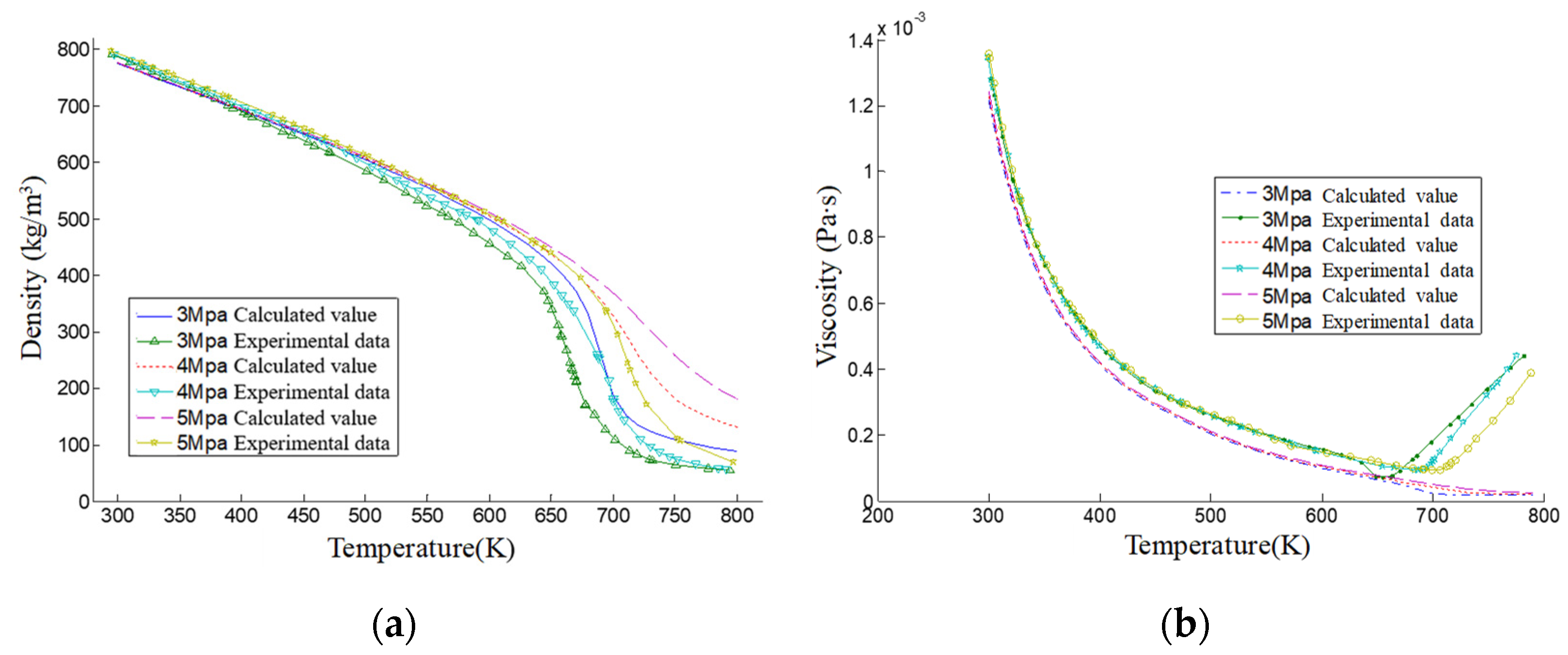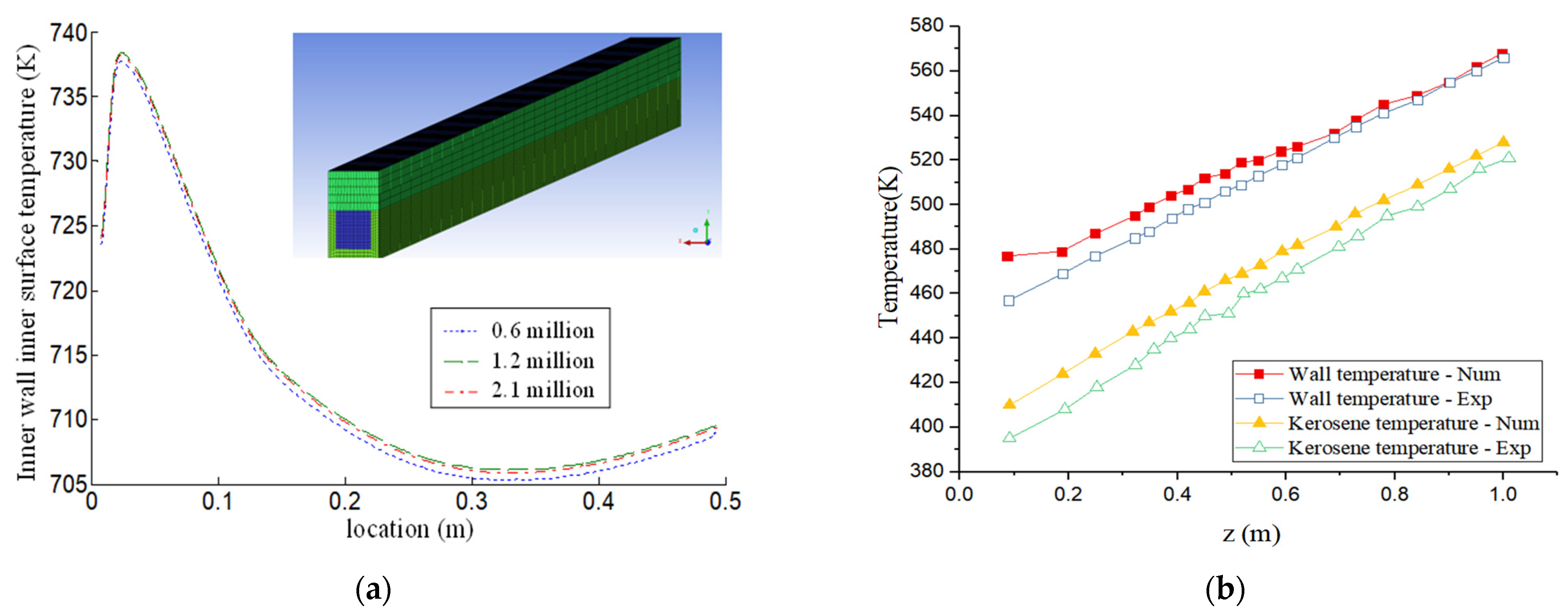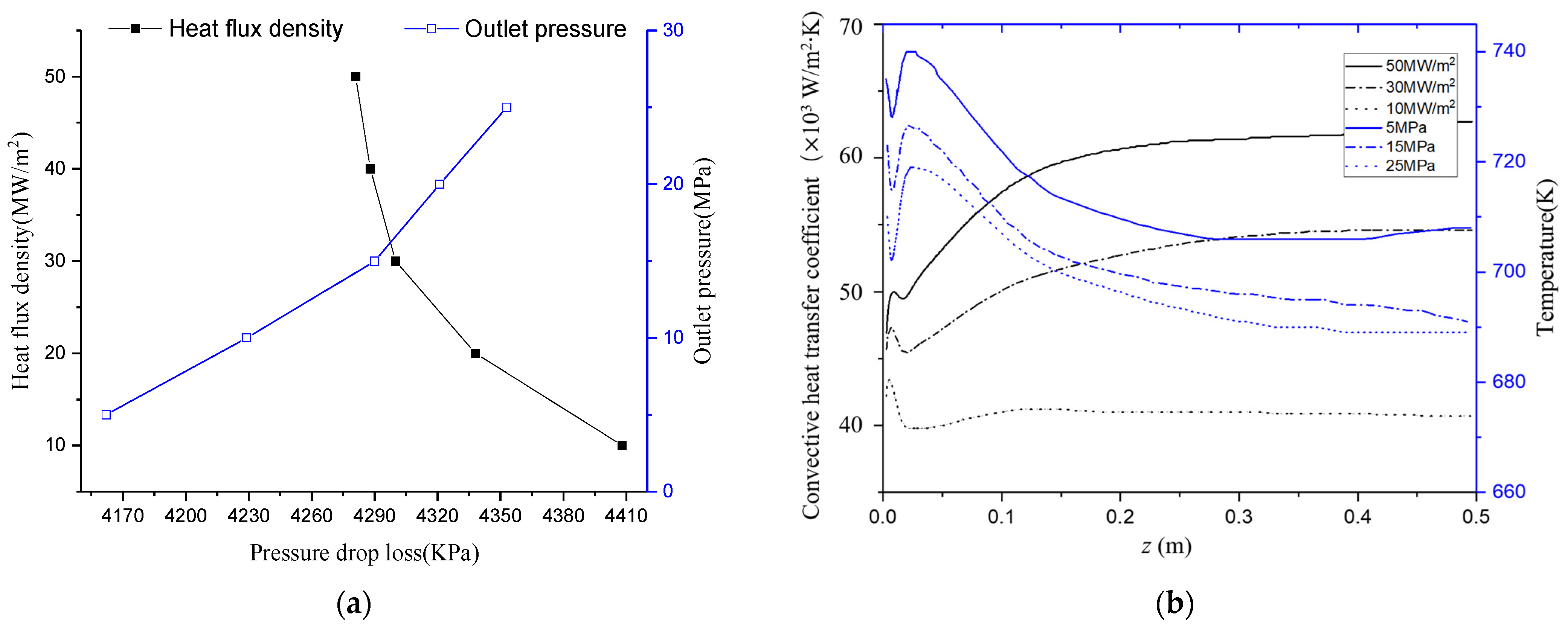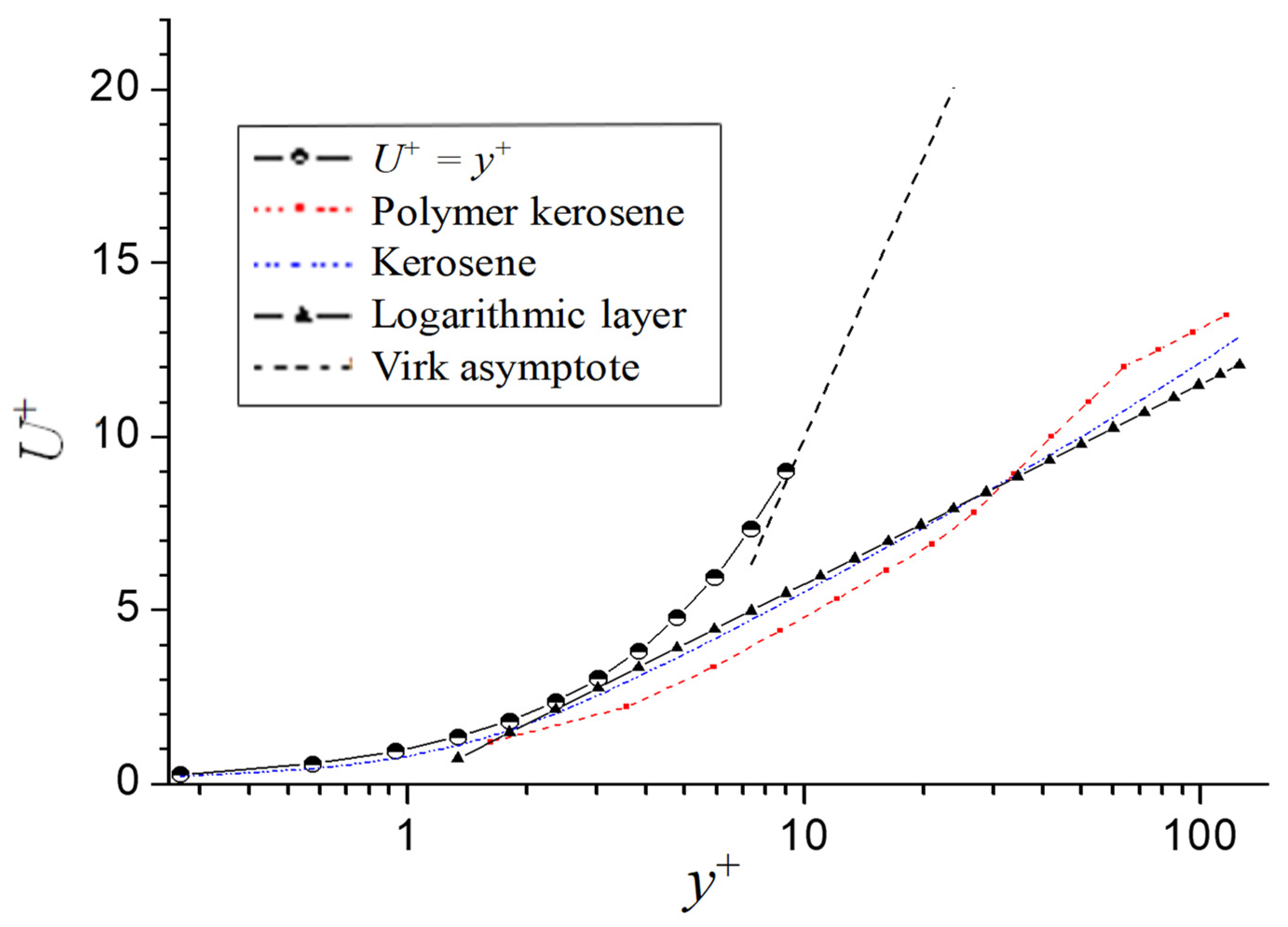Numerical Study on Influences of Drag Reducing Additive in Supercritical Flow of Kerosene in a Millichannel
Abstract
:1. Introduction
2. Methodology
2.1. Physical Model and Cases Design
2.2. Viscoelastic Medium
2.3. Material Properties
2.4. Numerical Scheme and Validation
3. Results
3.1. Pure Kerosene Flow in Rectangular Channel
3.2. Effects of the Polymer Additive
4. Conclusions
Author Contributions
Funding
Data Availability Statement
Acknowledgments
Conflicts of Interest
References
- Liu, Z.; Pan, H.; Feng, S.; Bi, Q. Dynamic behaviors of coking process during pyrolysis of China aviation kerosene RP-3. Appl. Therm. Eng. 2015, 91, 408–416. [Google Scholar] [CrossRef]
- Fu, Y.; Tao, Z.; Xu, G.; Deng, H.; Jia, Z. Experimental Study of Flow Distribution for Aviation Kerosene in Parallel Helical Tubes Under Supercritical Pressure. Appl. Ther. Eng. 2015, 90, 102–109. [Google Scholar] [CrossRef]
- Rashed, M.K.; Salleh, M.A.M.; Abdulbari, H.A.; Ismail, M.H.S. Enhancing the Drag Reduction Phenomenon within a Rotating Disk Apparatus Using Polymer-Surfactant Additives. Appl. Sci. 2016, 6, 355. [Google Scholar] [CrossRef] [Green Version]
- Paterson, R.W.; Abernathy, F.H. Turbulent flow drag reduction and degradation with dilute polymer solutions. J. Fluid Mechan. 1970, 43, 689–710. [Google Scholar] [CrossRef]
- Berman, N.S. Evidence for molecular interactions in drag reduction in turbulent pipe flows. Polymer Eng. Sci. 1980, 20, 451–455. [Google Scholar] [CrossRef]
- Dai, J.L.; Li, W.D.; Xa, X. Studies on the relationship between drag reduction and coil dimension of polymer reducer. Oilfield Chem. 1989, 6, 60–66. CNKI:SUN:YJHX.0.1989-01-009. (In Chinese) [Google Scholar]
- Brostow, W. Drag reduction and mechanical degradation in polymer solutions in flow. Polymers 1983, 24, 631–638. [Google Scholar] [CrossRef]
- Liaw, G.C.; Zakin, J.L.; Patterson, G.K. Effects of molecular characteristics of polymers on drag reduction. Aiche J. 1971, 17, 391–397. [Google Scholar] [CrossRef]
- Novelli, G.; Ferrari, L.A.; Vargas, G.G.; Loureiro, B.V. A synergistic analysis of drag reduction on binary polymer mixtures containing guar gum. Int. J. Biol. Macromol. 2019, 137, 1121–1129. [Google Scholar] [CrossRef]
- Wu, Y.G.; Zhao, X.D.; Liao, Q.D. The prediction and time-average velocity distribution of dilute polymer solutions drag reduction in pipe flow. J. Shanghai Instit. Mechan. Eng. 1987, 7, 4–8. (In Chinese) [Google Scholar]
- Cai, W.H.; Li, F.C.; Zhang, H.N. DNS study of decaying homogeneous isotropic turbulence with polymer additives. J. Fluid Mechan. 2010, 665, 334–356. [Google Scholar] [CrossRef]
- Li, C.F.; Xu, S.D.; Feng, X.D.; Wang, Y.H. Numerical simulation on heat transfer characteristics for turbulent drag-reducing flow with additives. Drain. Irrig. Machin. 2009, 27, 196–199. (In Chinese) [Google Scholar]
- Ebrahimi, A.; Naranjani, B.; Milani, S.; Javan, F.D. Laminar convective heat transfer of shear-thinning liquids in rectangular channels with longitudinal vortex generators. Chem. Eng. Sci. 2017, 173, 264–274. [Google Scholar] [CrossRef]
- Gong, K.; Cao, Y.; Feng, Y.; Zhang, Y.; Qin, J. Flow and Mass Transfer of Pyrolytic Aviation Kerosene in Curved Channel. J. Thermophys. Heat Transf. 2021, 35, 53–62. [Google Scholar] [CrossRef]
- Edwards, T.; Maurice, L.Q. Surrogate Mixtures to Represent Complex Aviation and Rocket Fuels. J. Propuls. Power 2001, 17, 461–466. [Google Scholar] [CrossRef]
- Bruno, T.J.; Huber, M.L. Evaluation of the Physicochemical Authenticity of Aviation Kerosene Surrogate Mixtures. Part 2: Analysis and Prediction of Thermophysical Properties. Energy Fuels 2010, 24, 4266–4276. [Google Scholar] [CrossRef]
- Zhang, Y.J.; Zhong, F.Q.; Xing, Y.F.; Zhang, X.Y. Numerical study on turbulent flow and convection heat transfer in right-angle elbow of supercritical kerosene. In Proceedings of the Chinese Congress of Theoretical and Applied Mechanics-2015 Proceeding, Chengdu, China, 25–27 December 2015. (In Chinese). [Google Scholar]
- Bird, R.B. Useful Non-Newtonian Models. Annu. Rev. Fluid Mech. 1976, 8, 13–34. [Google Scholar] [CrossRef]
- Jia, Z.X.; Xu, G.Q.; Deng, H.W.; Wen, J. Dynamic viscosity measurements of aviation hydrocarbon fuel RP-3 at sub-critical pressures. J. Beijing Univ. Aeronaut. Astronaut. 2014, 40, 934–938. (In Chinese) [Google Scholar]
- Zhong, F.; Fan, X.; Yu, G.; Li, J.; Sung, C.-J. Heat Transfer of Aviation Kerosene at Supercritical Conditions. J. Thermophys. Heat Transf. 2009, 23, 543–550. [Google Scholar] [CrossRef] [Green Version]
- Deng, H.W.; Zhang, C.B.; Xu, G.Q.; Tao, Z.; Liu, G.Z. Density Measurements of Endothermic Hydrocarbon Fuel at Sub- and Supercritical Conditions. J. Chem. Eng. Data 2011, 56, 2980–2986. [Google Scholar] [CrossRef]
- Deng, H.W.; Zhang, C.B.; Xu, G.Q.; Zhang, B.; Tao, Z.; Zhu, K. Viscosity Measurements of Endothermic Hydrocarbon Fuel from (298 to 788) K under Supercritical Pressure Conditions. J. Chem. Eng. Data 2012, 57, 358–365. [Google Scholar] [CrossRef]
- Zhu, J.; Tao, Z.; Deng, H.; Wang, K.; Yu, X. Numerical investigation of heat transfer characteristics and flow resistance of kerosene RP-3 under supercritical pressure. Int. J. Heat Mass Transf. 2015, 91, 330–341. [Google Scholar] [CrossRef]
- Virk, P.S. Drag reduction fundamentals. Aiche J. 1975, 21, 625–656. [Google Scholar] [CrossRef]








Publisher’s Note: MDPI stays neutral with regard to jurisdictional claims in published maps and institutional affiliations. |
© 2021 by the authors. Licensee MDPI, Basel, Switzerland. This article is an open access article distributed under the terms and conditions of the Creative Commons Attribution (CC BY) license (https://creativecommons.org/licenses/by/4.0/).
Share and Cite
Li, B.; Li, W.; Zheng, X.; Wang, Y.; Tang, M.; Cai, W. Numerical Study on Influences of Drag Reducing Additive in Supercritical Flow of Kerosene in a Millichannel. Energies 2021, 14, 6758. https://doi.org/10.3390/en14206758
Li B, Li W, Zheng X, Wang Y, Tang M, Cai W. Numerical Study on Influences of Drag Reducing Additive in Supercritical Flow of Kerosene in a Millichannel. Energies. 2021; 14(20):6758. https://doi.org/10.3390/en14206758
Chicago/Turabian StyleLi, Biao, Wenxi Li, Xin Zheng, Yue Wang, Mingming Tang, and Weihua Cai. 2021. "Numerical Study on Influences of Drag Reducing Additive in Supercritical Flow of Kerosene in a Millichannel" Energies 14, no. 20: 6758. https://doi.org/10.3390/en14206758
APA StyleLi, B., Li, W., Zheng, X., Wang, Y., Tang, M., & Cai, W. (2021). Numerical Study on Influences of Drag Reducing Additive in Supercritical Flow of Kerosene in a Millichannel. Energies, 14(20), 6758. https://doi.org/10.3390/en14206758





